Hanoi Rooftop Nem Ran

It is easy to be consumed by Hanoi. The hysterical ballet of endless motorcycles constantly threatens to knock you over, yet somehow never does. Instead they flow in a kind of hypnotic harmony without the aid of any traffic lights or commands, cutting seamlessly into each other as if they were riding to a soundtrack we cannot hear. In the Old Quarter, some streets are still lined by vendors and artisans specialising in the craft that the lane was named after. Lanes dedicated to flowers, silver, buttons and thread; one street is stuffed with baking equipment, every shop displaying their cupcake and madeleine trays, in aluminium or colourful plastic. Hanoi invariably stimulates, every corner has something to look at, something to listen to, something to eat. A circus to digest in a very beautiful setting.
Once known as the “Soaring Dragon”, the capital of Hanoi has seen many rulers, from the Chinese occupation during the Ming Dynasty, to the Japanese invasion of the 1940s and its alternating role as capital of French Indochina. This complex history has heavily influenced its food and drink, noodles and buns from China, red wine and flan caramel from France. We had come here to eat, knowing we would find some of the best food from this journey. What we did not expect to find, was a second home in Hanoi.
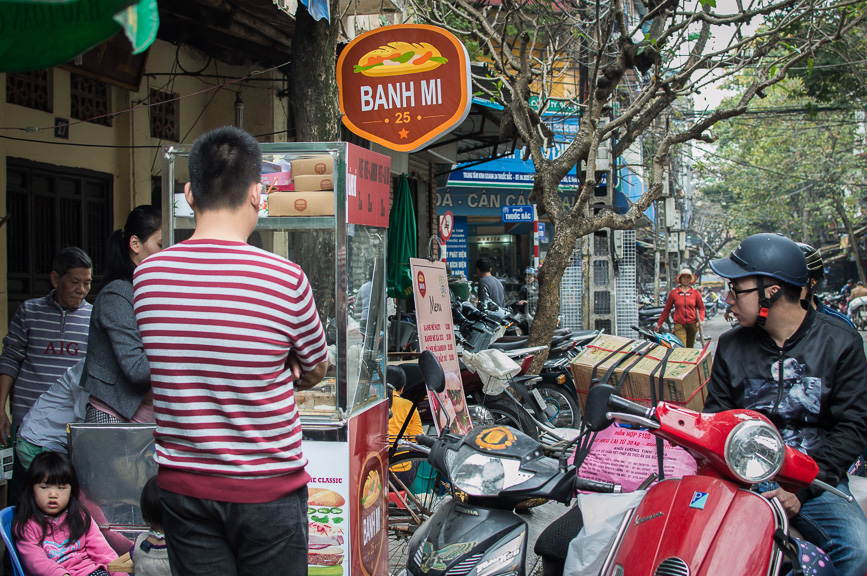
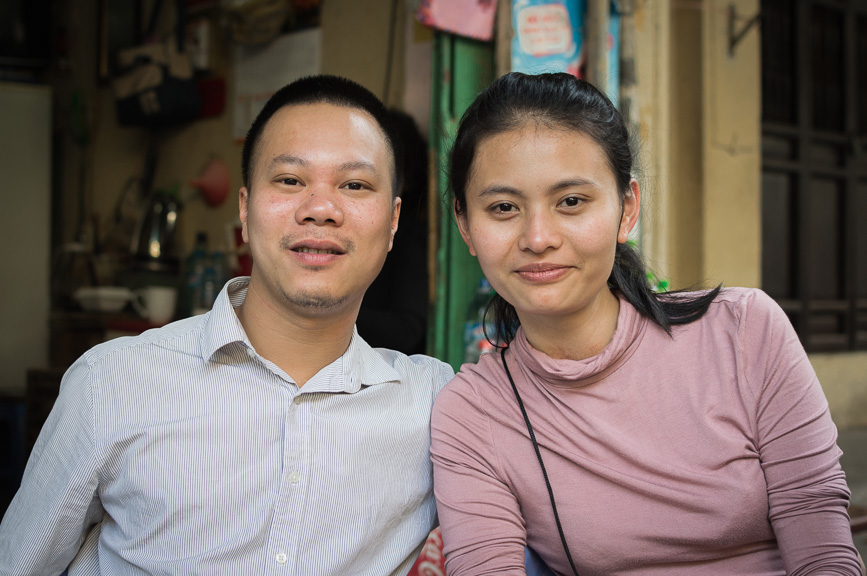
We had just eaten something delicious, some kind of “bánh” or another, and were exploring the neighbourhood to make room for more food, when we came across a tiny stall called Bánh Mi 25. We had already munched on our fair share of Bánh Mi since arriving in Vietnam and were clearly far from hungry, but there was no convincing Nico. Who can deny a frenchman yet another crispy baguette with rich pâté, fatty roast pork, dreamy dark sauce and a celebration of crudités and herbs? No one.
So we sat down on little green plastic stools and waited for our baguette to be heated up, when Phuong came over to say hello. Stylishly dressed, (he may be the first person in Hanoi we spot in faded green trousers) we have a chat with him and his lovely wife Ha, as she prepared our one bánh mi-to-share–and-go with the care of a pro. All home-made ingredients are sliced and layered before she slides them into the core of the warm, slathered in mayonnaise, bread. A sprinkle of coriander and parsley and it was ready to be packed into a cute little brown box with their logo on it, free banana to boot. A street stall with custom made doggy-boxes was a first for us in Vietnam. Above the boxes, we spot the classic enamel mug that you still see occasionally in Asia, white with a blue rim and bold red and orange flowers. We ask Phuong if he knows where we can buy some and he tells us that only one factory in Vietnam produces them, but that he knows a wholesale place in the market, he can take us there the next morning.
He did and we ended up passing by their place at least once a day during our stay in Hanoi. Every day, Phuong’s mother manages the accounts of the padlock shop housed in the ground floor of this old Hanoi family house and his uncle served us tea from a homemade thermos in between reading stories to his granddaughter.
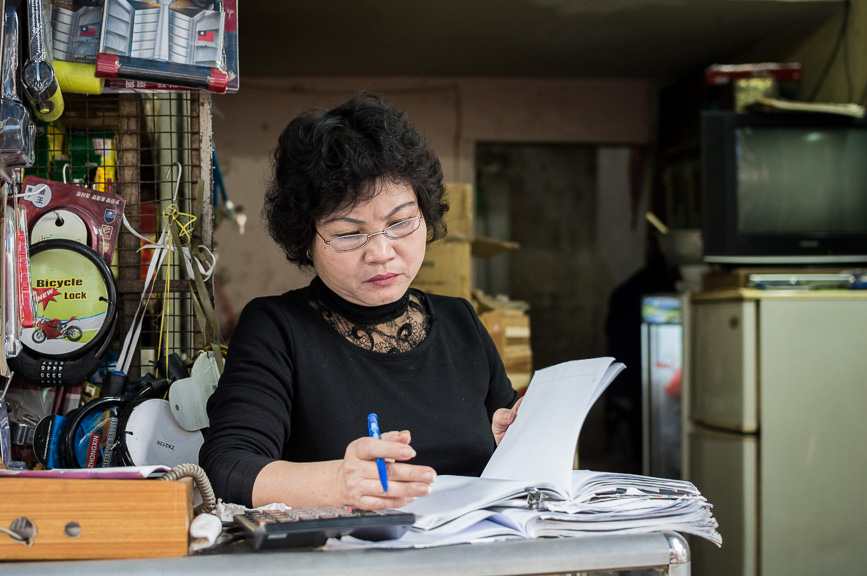
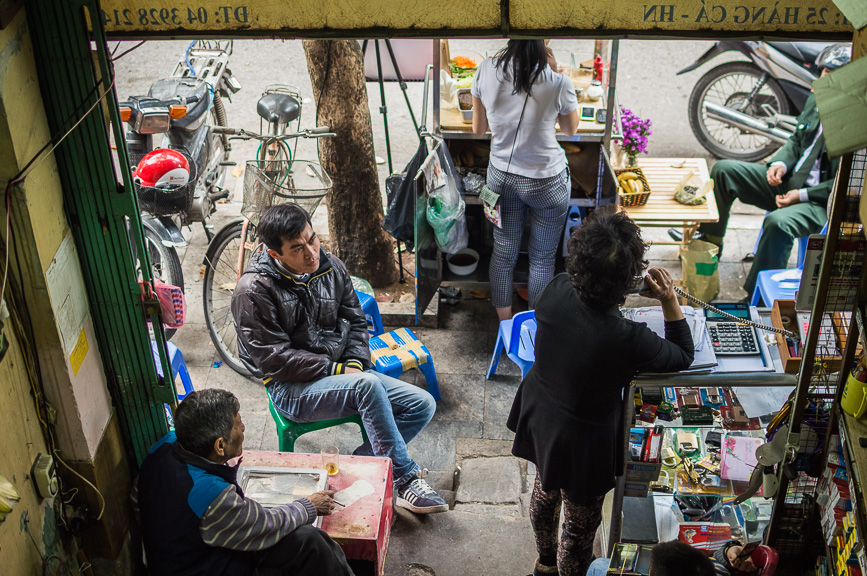
Over the course of a week, there was always some surprise waiting for us. Phuong introduced us to the best bánh gio in town from a lady who has been making them fresh since his childhood and to a midnight snack from a doctor-turned-street-food-seller who decided to continue his father’s legacy of making the best papaya salad in Hanoi. We learned to make his grandfather’s pork liver pâté in his rooftop kitchen and partied there with his friends on a friday night where stories from their days as students in Moscow were exchanged, Russian food and all. One evening we brought xoi che (sticky rice desserts) for everyone to share and ended up staying for the family dinner. More soup, more noodles, more tea, more beer.
Phuong is a people person. He radiates a warmth that only someone who is happy can transmit. An engineer by trade, this is not the first time he has taken a risk and decided to go for something completely new. He spent years building a successful travel agency, where he met Ha, before deciding to leave all that behind and open up a small bánh mi stand. Bánh Mi 25 had only opened for a couple of months when we stumbled across it that day and has now soared to being the number one restaurant in Hanoi on Tripadvisor. Not strictly a restaurant since Tripadvisor does not differentiate between different kinds of food establishments, this incredible success story is down to their hard work and unbeatable personalities. By following his passion and changing his day job, Phuong now has more time to spend with his family and friends, and luckily for us, teach us how to cook!
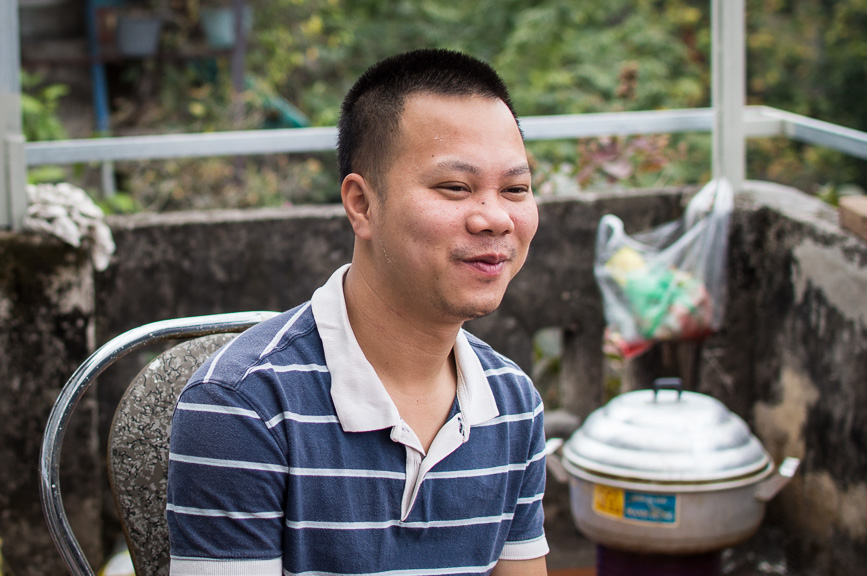

When he offered to teach us the classic nem rán recipe his family has made for years, we jumped on board. As we walked up the now familiar stone steps towards the rooftop kitchen, we left the roar of Hanoi’s streets behind us and entered Phuong’s happy place. A place where homemade pâté steams over a small wood-burning oven, fresh nem are wrapped in delicate rice paper and Bordeaux flows freely in old school enamel mugs.
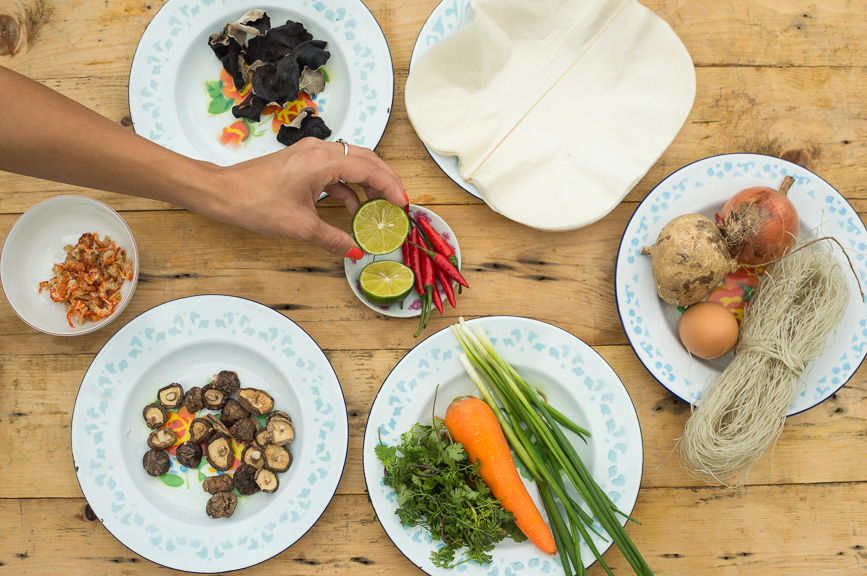
HANOI ROOFTOP NEM RÁN \ˌhænɒj ruftɑp nem rán\
Nem is one of the most popular culinary exports from Vietnam. Chances are you have tried one even if you have never set foot in a Vietnamese restaurant. In Vietnam, they are called Chả giò or Nem rán in the North, literally meaning “fried sausage”. Freshly made and dipped in strong nước mắm pha sauce, they are still one of my favourite things about Vietnamese street food. These ones from Phuong are the best we have had so far. Do not be intimidated by the long list of ingredients, once you gather them all, the rolls are actually easy to make and perfect if you are having company over. Make guests help and get in on the action as well. This recipe lends very well to division of labour in the kitchen (chopping, mixing, rolling, frying) and everyone will definitely have more fun.
Serves 4
For the nem rán
300 g of ground pork
1/3 cup dried shrimps
1/3 cup dried shitake mushrooms
4 pieces of dried wood ear mushrooms
1/2 small onion
4 small spring onions
1/2 carrot
1/2 small jicama or kohlrabi, peeled
1 egg, beaten
3 1/2 tsp chinese dried egg powder (optional)
1/2 tsp ground black pepper
1 tsp salt
Vietnamese rice paper (bánh trang) square or round, for wrapping
Vegetable oil for cooking
For the nước mắm pha
4 tbsp vietnamese fish sauce, nước mắm
1 1/2 heaping tsp white granulated sugar
4 tsp of base vinegar mix (quick recipe below)
1/2 cup water
a squeeze of lime juice
a sprinkle of freshly-ground black pepper
Fresh coriander to serve
Base vinegar mix
Line the base of a clean sterilised screw-top jar with about 20 halved garlic cloves and add a couple of chopped bird’s eye chillies depending on how much kick you want it to have. Fill the jar with white distilled vinegar and leave to strengthen over a few days. Store this in a cool and dry place or in the fridge and keep using it whenever you want. Make again.
To make the nem rán filling
Place the dried mushrooms in a bowl and cover with hot water to soak and soften. Do the same for the dried shrimps. Once they are soft, drain and finely chop the mushrooms into thin shreds and the mince the shrimps.
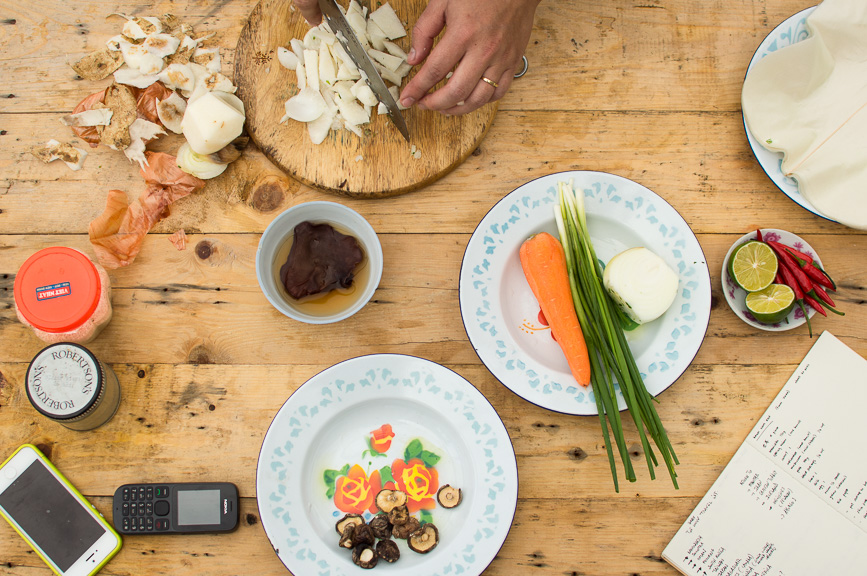

Finely chop the onions and spring onions. Slice the jicama/kohlrabi and carrot into long thin strips. Place the ground pork, onions, spring onions, mushrooms, shrimps, jicama/kohlrabi and carrot into a big bowl and mix. The secret here is the beaten egg, it holds everything in the nem rán together much like a meatball and gives it a richer texture. Add the beaten egg to the mixture and sprinkle in salt, pepper and dried egg powder if using.
Place the filling aside to let the flavours blend while you prepare the nước mắm pha dipping sauce.
To make the nước mắm pha
Mix the fish sauce and sugar in a bowl, until sugar dissolves. Add vinegar mix and half a cup of water. Taste and add more sugar or fish sauce to taste. Finish off with a squeeze of lime juice and a sprinkle of black pepper.
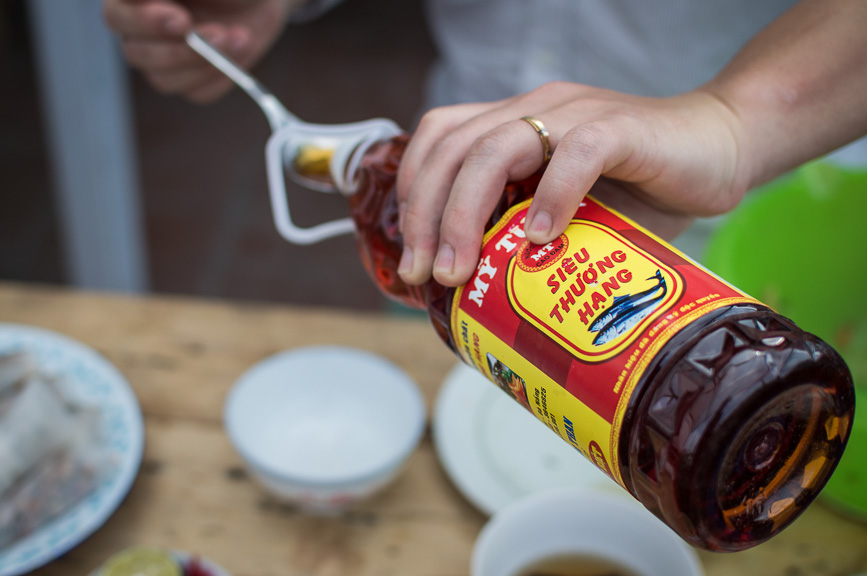
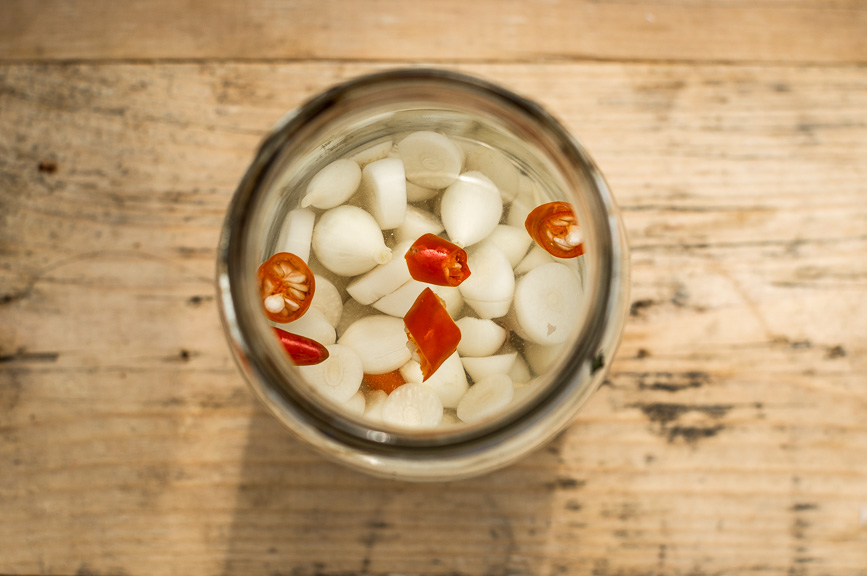
To roll the nem rán
Lay out a sheet of dry rice paper on a flat surface. Take about two tablespoons of filling and line it up near the edge of the rice paper like a sausage. Fold over the short edge once to cover the filling then fold in the rice paper from left and right to close the filling in securely. Continue rolling towards the end of the rice paper and set aside until ready to cook. Continue until all the filling is finished.
* Note on rice paper bánh trang:
Rice paper in Vietnam seems to be more delicate than the ones we find at asian supermarkets abroad. Once the filling is laid out, the version we used in Vietnam softened quickly. If you only find the harder thicker version at home, then you can also dip them quickly in a bowl of room-temperature water and dry on a kitchen towel before wrapping. This makes them easier to handle.
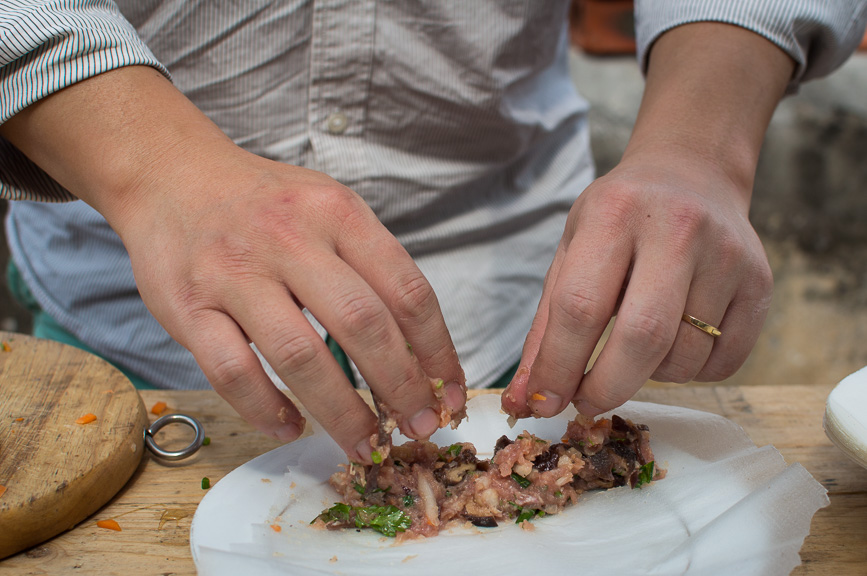
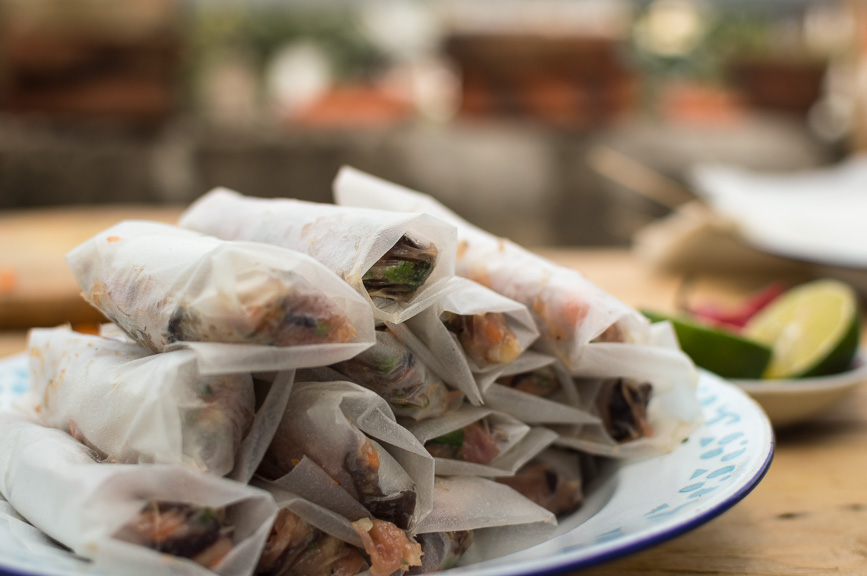
To cook and serve
Once your nem rán are ready to cook, use a shallow pan and fill it with vegetable oil until about 2cm high. Heat over medium heat and fry the nem rán at a constant low sizzle until golden. Be gentle while lowering the nem rán into the pan so that they do not stick to each other and end up breaking the fragile wrapping. Prepare a plate with a layer of kitchen paper to soak up the excess oil and transfer the nem rán once ready.
To serve, provide everyone with their own dipping bowl and fill with a couple of tablespoons of nước mắm pha and some fresh coriander. Add some extra black pepper if you like and get dipping!
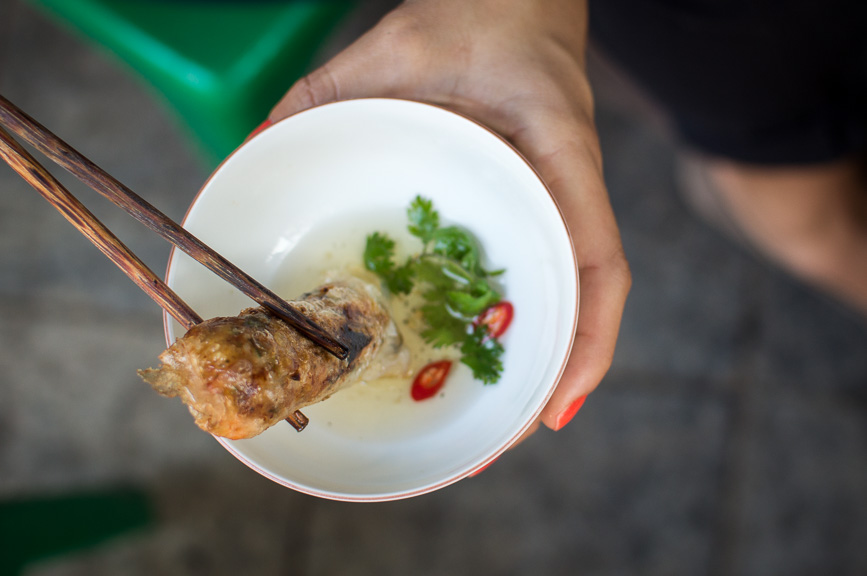
Thank you Phuong and Ha for taking care of us in Hanoi, we will be back!

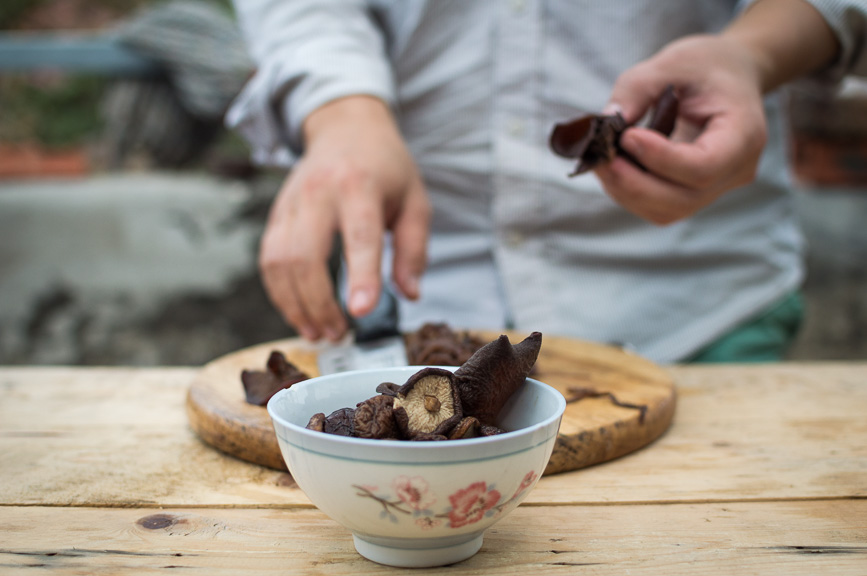
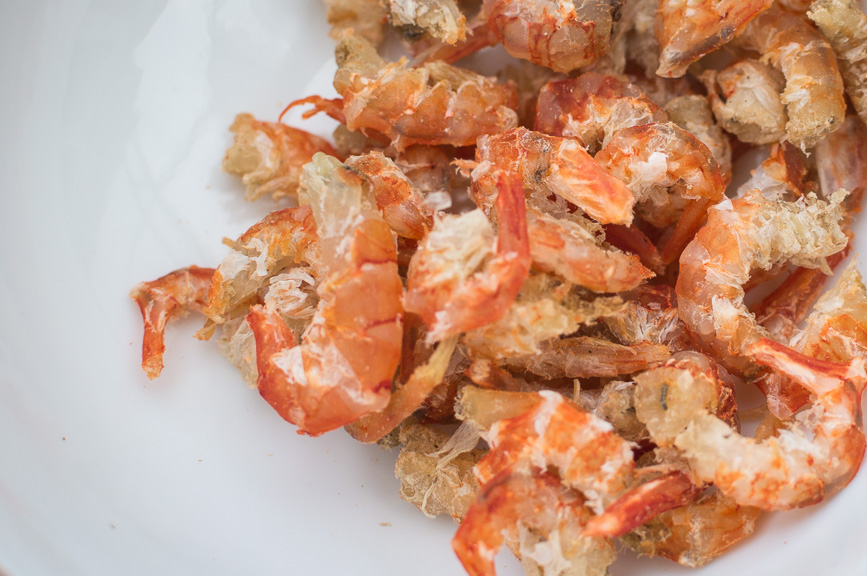










4 Comments
Jordan
April 21, 2015Absolutely beautiful photos! The food looks delicious and the view from the rooftop is so lovely. Thanks for sharing!
Nico & Gabi
April 22, 2015Thanks Jordan!
Rachel
March 21, 2017Hello – I came across your blog and nice article! You came up on my Google search for enamel mugs. Wish I knew about the Banh Mi 25 before – will visit it after your recommendation. 😀 Do you happen to remember the factory address he mentioned about the enamel mugs as well?
Nico & Gabi
March 21, 2017Hi Rachel,
You should definitely go visit, we understand he has expanded the restaurant now! Unfortunately the factory was actually closing at the time from what we can remember. We don’t have the address of the factory itself, but we found the enamel mugs in a specific shop that Phuong brought us to somewhere near the Dong Xuan market…
The Cong Caphe however sold enamel mugs at most of its cafés too and they are also really pretty and similar.
Hope that helps! xx